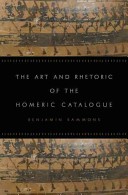
Benjamin Sammons, The Art and Rhetoric of the Homeric Catalogue. Oxford/New York: Oxford University Press, 2010. Pp. x, 233.
- ISBN 9780195375688.
- $74.00.
Recension par D. Thomas Benediktson (University of Tulsa) dans Bryn Mawr Classical Review 2010.09.55.
Extraits en ligne sur amazon.fr.
Présentation de l'éditeur:
In The Art and Rhetoric of the Homeric Catalogue, Benjamin Sammons takes a fresh look at a familiar element of the Homeric epics -- the poetic catalogue. This study uncovers the great variety of functions fulfilled by the catalogue as a manner of speech within very different contexts, ranging from celebrated examples such as the poet's famous "Catalogue of Ships," to others less commonly treated under this rubric, such as catalogues within the speech and rhetoric of Homer's characters. Sammons shows that catalogue poetry is no ossified or primitive relic of the old tradition, but a living subgenre of poetry that is used by Homer in a creative and original way. He finds that catalogues may be used by the poet or his characters to reflect -- or distort -- the themes of the poem at large, to impose an interpretation on events as they unfold, and possibly to allude to competing poetic traditions or even contemporaneous poems. Throughout, the study focuses on how Homer uses his catalogue to talk about the epic genre itself: to explore the boundaries of the heroic world, the limits of heroic glory, and the ideals and realities of his own traditional role as an epic bard. Building on a renewed interest in the "literary list" in other disciplines, Sammons shows that Homer is not only one of the earliest known practitioners of the poetic catalogue, but one of the subtlest and most skillful.
Benjamin Sammons, a Homerist, is author of several articles on catalogue poetry, Homeric rhetoric, characterization, and narrative structure.
Table des matières:
Preface
INTRODUCTION
CHAPTER 1: Two Paradigmatic Catalogues
1.1 Dione
1.2 Kalypso
CHAPTER 2: Two Catalogues of Women
2.1 Zeus's Catalogue of Lovers
2.2 The Catalogue of the Nekyia
CHAPTER 3: Two Catalogues of Objects
3.1 Priam's Ransom
3.2 Agamemnon's Catalogue of Gifts
CHAPTER 4: The Iliadic Catalogue of Ships
CHAPTER 5: Three Catalogues of Suitors
CONCLUSIONS